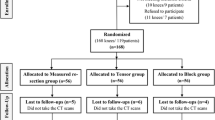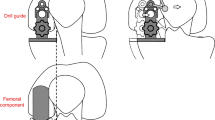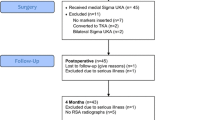Abstract
Purpose
Although the spacer block technique has been recommended for the implantation of unicompartmental knee arthroplasty (UKA), there is still a lack of data concerning the resulting component positioning.
Methods
This retrospective study included 193 consecutive patients who had undergone medial UKA using the spacer technique. On the basis of the postoperative long standing radiographs, the coronal component alignment was determined in relation to the mechanical axes and the sagittal component alignment in relation to the anatomical axes of the tibia and femur. The coronal alignment of the femoral component was determined through post hoc 3D planning with the CAD data projected onto the radiograph.
Results
The angle of the tibial component was on the average 2.3° ± 2.8° in varus, the femoral component on the average 2.6° ± 3.7° in varus. Only 4 implants (2%) were outside an assumed tolerance range of 10° varus–10° valgus. A tilting from the femoral to the tibial component of more than 10° was observed in 8 cases (4%). A valgus positioning of the tibial component was followed by a valgus alignment of the femoral component (R = − 0.194, p = 0.007). An increased posterior slope of the tibial component led to an extended positioning of the femoral component (R = − 0.230, p = 0.001).
Conclusions
The spacer block technique produces results comparable to the intramedullary guided technique. However, the precision is low and outlier frequent. Due to the possibility of transferring a tibial malalignment to a femoral malalignment, even greater attention should be paid to the precision of tibial resection.




Similar content being viewed by others
References
Iacono F, Raspugli GF, Akkawi I et al (2016) Unicompartmental knee arthroplasty in patients over 75 years: a definitive solution? Arch Orthop Trauma Surg 136:117–123. https://doi.org/10.1007/s00402-015-2323-6
Hawi N, Plutat J, Kendoff D et al (2016) Midterm results after unicompartmental knee replacement with all-polyethylene tibial component: a single surgeon experience. Arch Orthop Trauma Surg 136:1303–1307. https://doi.org/10.1007/s00402-016-2515-8
Kleeblad LJ, van der List JP, Zuiderbaan HA, Pearle AD (2017) Larger range of motion and increased return to activity, but higher revision rates following unicompartmental versus total knee arthroplasty in patients under 65: a systematic review. Knee Surg Sports Traumatol Arthrosc. https://doi.org/10.1007/s00167-017-4817-y
Mohammad HR, Strickland L, Hamilton TW, Murray DW (2017) Long-term outcomes of over 8,000 medial Oxford Phase 3 Unicompartmental Knees-a systematic review. Acta Orthop. https://doi.org/10.1080/17453674.2017.1367577
Matziolis G, Röhner E (2015) Arthritis of the medial knee joint compartment. Z Orthop Unfall 153:553–564. https://doi.org/10.1055/s-0035-1557834 (quiz 565–6)
Levine B, Rosenberg AG (2014) The simple unicondylar knee: extramedullary technique. Clin Sports Med 33:77–85. https://doi.org/10.1016/j.csm.2013.06.003
Kort NP, van Raay JJAM., Thomassen BJW (2007) Alignment of the femoral component in a mobile-bearing unicompartmental knee arthroplasty: a study in 10 cadaver femora. Knee 14:280–283. https://doi.org/10.1016/j.knee.2007.04.007
Ma B, Long W, Rudan JF, Ellis RE (2006) Three-dimensional analysis of alignment error in using femoral intramedullary guides in unicompartmental knee arthroplasty. J Arthroplasty 21:271–278. https://doi.org/10.1016/j.arth.2004.07.012
Kim JG, Kasat NS, Bae JH et al (2012) The radiological parameters correlated with the alignment of the femoral component after Oxford phase 3 unicompartmental knee replacement. J Bone Jt Surg Br 94:1499–1505. https://doi.org/10.1302/0301-620X.94B11.29217
Gulati A, Chau R, Simpson DJ et al (2009) Influence of component alignment on outcome for unicompartmental knee replacement. Knee 16:196–199. https://doi.org/10.1016/j.knee.2008.11.001
Shakespeare D, Ledger M, Kinzel V (2005) Accuracy of implantation of components in the Oxford knee using the minimally invasive approach. Knee 12:405–409. https://doi.org/10.1016/j.knee.2005.03.003
Jang K-M, Lim HC, Han S-B et al (2017) Does new instrumentation improve radiologic alignment of the Oxford® medial unicompartmental knee arthroplasty? Knee 24:641–650. https://doi.org/10.1016/j.knee.2017.02.001
Alvand A, Khan T, Jenkins C et al (2017) The impact of patient-specific instrumentation on unicompartmental knee arthroplasty: a prospective randomised controlled study. Knee Surg Sports Traumatol Arthrosc. https://doi.org/10.1007/s00167-017-4677-5
Suzuki T, Ryu K, Kojima K et al (2015) Evaluation of spacer block technique using tensor device in unicompartmental knee arthroplasty. Arch Orthop Trauma Surg 135:1011–1016. https://doi.org/10.1007/s00402-015-2231-9
Ham ten AM, Heesterbeek PJC, van der Schaaf DB et al (2013) Flexion and extension laxity after medial, mobile-bearing unicompartmental knee arthroplasty: a comparison between a spacer- and a tension-guided technique. Knee Surg Sports Traumatol Arthrosc 21:2447–2452. https://doi.org/10.1007/s00167-012-2021-7
Kim S-J, Bae J-H, Lim HC (2012) Factors affecting the postoperative limb alignment and clinical outcome after Oxford unicompartmental knee arthroplasty. J Arthroplasty 27:1210–1215. https://doi.org/10.1016/j.arth.2011.12.011
Inoue A, Arai Y, Nakagawa S et al (2016) Comparison of alignment correction angles between fixed-bearing and mobile-bearing UKA. J Arthroplasty 31:142–145. https://doi.org/10.1016/j.arth.2015.07.024
Clarius M, Hauck C, Seeger JB et al (2010) Correlation of positioning and clinical results in Oxford UKA. Int Orthop 34:1145–1151. https://doi.org/10.1007/s00264-009-0881-3
Müller PE, Pellengahr C, Witt M et al (2004) Influence of minimally invasive surgery on implant positioning and the functional outcome for medial unicompartmental knee arthroplasty. J Arthroplasty 19:296–301
Tu Y, Xue H, Ma T et al (2017) Superior femoral component alignment can be achieved with Oxford microplasty instrumentation after minimally invasive unicompartmental knee arthroplasty. Knee Surg Sports Traumatol Arthrosc 25:729–735. https://doi.org/10.1007/s00167-016-4173-3
Weber P, Crispin A, Schmidutz F et al (2013) Improved accuracy in computer-assisted unicondylar knee arthroplasty: a meta-analysis. Knee Surg Sports Traumatol Arthrosc 21:2453–2461. https://doi.org/10.1007/s00167-013-2370-x
Zhang Z, Zhu W, Zhu L, Du Y (2016) Superior alignment but no difference in clinical outcome after minimally invasive computer-assisted unicompartmental knee arthroplasty (MICA-UKA). Knee Surg Sports Traumatol Arthrosc 24:3419–3424. https://doi.org/10.1007/s00167-014-3456-9
Gaudiani MA, Nwachukwu BU, Baviskar JV et al (2017) Optimization of sagittal and coronal planes with robotic-assisted unicompartmental knee arthroplasty. Knee 24:837–843. https://doi.org/10.1016/j.knee.2017.05.002
van der List JP, Chawla H, Joskowicz L, Pearle AD (2016) Current state of computer navigation and robotics in unicompartmental and total knee arthroplasty: a systematic review with meta-analysis. Knee Surg Sports Traumatol Arthrosc 24:3482–3495. https://doi.org/10.1007/s00167-016-4305-9
Cobb J, Henckel J, Gomes P et al (2006) Hands-on robotic unicompartmental knee replacement: a prospective, randomised controlled study of the acrobot system. J Bone Jt Surg Br 88:188–197. https://doi.org/10.1302/0301-620X.88B2.17220
Lonner JH, John TK, Conditt MA (2010) Robotic arm-assisted UKA improves tibial component alignment: a pilot study. Clin Orthop Relat Res 468:141–146. https://doi.org/10.1007/s11999-009-0977-5
MacCallum KP, Danoff JR, Geller JA (2016) Tibial baseplate positioning in robotic-assisted and conventional unicompartmental knee arthroplasty. Eur J Orthop Surg Traumatol 26:93–98. https://doi.org/10.1007/s00590-015-1708-0
van Leeuwen JAMJ., Röhrl SM (2017) Patient-specific positioning guides do not consistently achieve the planned implant position in UKA. Knee Surg Sports Traumatol Arthrosc 25:752–758. https://doi.org/10.1007/s00167-016-4268-x
Argenson J-NA, Parratte S (2006) The unicompartmental knee: design and technical considerations in minimizing wear. Clin Orthop Relat Res 452:137–142. https://doi.org/10.1097/01.blo.0000229358.19867.60
Author information
Authors and Affiliations
Corresponding author
Rights and permissions
About this article
Cite this article
Matziolis, G., Mueller, T., Layher, F. et al. The femoral component alignment resulting from spacer block technique is not worse than after intramedullary guided technique in medial unicompartimental knee arthroplasty. Arch Orthop Trauma Surg 138, 865–870 (2018). https://doi.org/10.1007/s00402-018-2911-3
Received:
Published:
Issue Date:
DOI: https://doi.org/10.1007/s00402-018-2911-3




